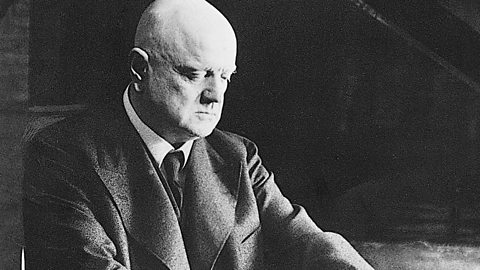Dates: b. 1865 / d. 1957
Nationality: Finnish
Period: 20th Century
Genre: Tone Poem
Key Musical Elements:
- Dynamics

Naomi Wilkinson explores Sibelius's ode to Finland with facts, insight and animation.
Sibelius loved Finland. One of his most beloved works is Finlandia, which is about the Finnish people overcoming their enemies. Written in 1899, Finlandia is a tone poem – this means it was composed to portray a particular story. It was written in protest against the increasing censorship by the Russian Empire which was taking place in the late 19th Century.
This is music about national identity. It captures not only the vast, majestic landscape of Finland but also its national pride at a crucial moment in the country's history.
How does music reflect our own national identity?
Listen out for: The hymn-like theme towards the end of the piece. This was later given words and is one of the most important national songs in Finland, second only to the real national anthem.
How does the dynamic choice that Sibelius makes colour the piece? The beginning is dark and foreboding and the brass play strongly, possibly representing a sense of threat. When the flutes enter it is gentler – possibly a sound of hope. Can you identify where the composer changes the dynamic for effect? Listen out for the timpani – they usually enter at a strong loud point in the music. Towards the end the brass play a fanfare like phrase and the whole orchestra builds to an even stronger and louder climax.
Watch the full performance of Sibelius's piece by the łÉČËżěĘÖ Symphony Orchestra.
Jean Sibelius
Undoubtedly the most famous composer ever to come out of Finland, Jean Sibelius (pronounced Zhaa(ng) Sib-ayli-uss) completed seven amazing symphonies and a host of vivid descriptive music using his beloved country as inspiration. After this at the age of 59, he abruptly retired from music and spent his remaining 30 years happily surrounded by his family. He said simply that his final 7th symphony could not be bettered - so why try?
Sibelius loved his country and frequently went for long walks in the forests near his home. These walks and the stories of ancient Finnish legends that he read and told his children became the basis for many of his compositions. Finnish people still hold his music close to their hearts. The school that he studied music at was renamed The Sibelius Academy, for many years his face was on Finnish money, and his birthday is celebrated every year as 'Finnish Music Day'.
MP3: Listen to or download the music
Download the
To save to your computer: PC - right-click and save, Mac - ctrl-click and save.
Lesson Plans
Six weeks of learning and activitiesDownload lesson plans for six weeks of learning and activities for Finlandia, as Powerpoint presentations or PDFs. These lesson plans are ideal for music lessons, but you can of course use the Ten Pieces in many other subjects and activities. Take a look at our video masterclasses for inspiration.
To enable all images to work in the PowerPoint files please save the file to your computer. To save to your computer: PC - right-click and save, Mac - ctrl-click and save.
Primary lesson plans:
Lesson plan by Rachel Leach
Suitable for:
- Key Stage 2 in England and Wales
- Second Level, P5-P7 in Scotland
- Key Stage 1/Key Stage 2 in Northern Ireland
Early years / KS1 resources
Inclusive resources
Arrangements: Play the piece with simplified parts
All parts have been designed to work together to enable mixed-ability groups to perform together. See more information about the parts below.
Beginner/pre-Grade 1:
- | | |
- | | | |
- | | | | |
Intermediate/Grade 1-3:
- | | | |
- | | | |
- | | | | | |
- | |
Grade 4-5:
- | | | |
- | | | | |
- | | | | | | | |
Other scores:
Figurenotes arrangement
Figurenotes is a simple, progressive way to learn to read and play music. Find out more about Figurenotes here
- |
Notes from the arranger
By Iain Farrington
All parts have been designed to work together to enable mixed-ability groups to perform together. A certain amount of simplification has been required to adapt the pieces for mixed-ability. Some pieces have been cut to allow a 3-5 minute general duration and to remove especially difficult passages of music. A successful rendering of each piece would require the essential melodic material and bass line which are often in the Grades 4/5 parts, especially in the piano.
There are scores for each difficulty level plus three other scores for each piece:
- Grouped according to ability
- Grouped according to instrument type
- 'Short score' in C, grouped according to ability
There are three ability levels – beginner, intermediate (Grades 1-3) and Grades 4-5.
- Flute parts can be played by the violins
- Oboe parts can be played by the flutes and violins
- Trumpet parts (in Bâ™) can be played by the clarinets
- Violin parts can be played by the flutes (except when in the lowest register)
- The 'percussion' part is a beginner part and can be played on any drum. It adds a simple rhythm layer to each piece. Timpani and full percussion parts are for intermediate or Grades 4/5
Please note:
Finlandia: This has been transposed down a semitone for ease of performance and to allow use of open strings. Note values have been halved in the first section until the Allegro at letter D (4/4 rather than 2/2) to allow counting in crotchets rather than minims. There are cuts from bars 39-50, 62-69, 78-81, 132-155 from the original.